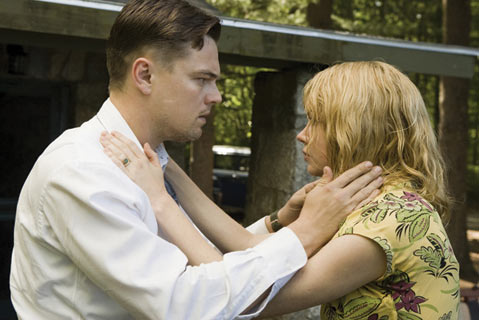Shutter Island
Leonardo DiCaprio, Ben Kingsley, and Mark Ruffalo start in a film written by Laeta Kalogridis, based upon the novel by Dennis Lehane, and directed by Martin Scorsese.

In the opening scenes of Martin Scorsese’s hypnotically fine and memorable Shutter Island, we meet our protagonist, played with proper fervency by Leonard DiCaprio, in his queasy boat ride to an uncertain destiny. Fog and foreboding set the stage. He is a federal marshal, looking into the disappearance of a prisoner/patient on a remote island-turned-mental-asylum, which includes a ward for the “most dangerous and damaged” criminally insane. We expect bad things to happen.
From first impressions, it appears that the post-WWII-period Shutter Island is another of Scorsese’s loving odes to the bygone cinematic aura and era of film noir, à la Cape Fear. And yet, without dipping into the sin of plot spoilers (which would be a particular critical crime in this case), let’s just say the plot thickens, along with the cinematic agenda. It has been casually reported that this is Scorsese’s homage to Hitchcock, but there are generous doses of David Lynch in the mix as well, through hallucinatory dreams, memories, and reality-tweaking asides. DiCaprio, by now a favorite in Scorsese’s acting stable, gets another ripe chance to continue his portrayal of mental warpitude, hinted at during his Howard Hughes turn in The Aviator.
This is a full-service suspense film that takes the notion of “suspense” to new heights and width. Are the imperious asylum honchos (played so smoothly by Ben Kingsley and Max von Sydow) as seemingly dubious as they appear, or are they wardens of sanity? Where is the line between fever dreams and gritty consensus consciousness?
What makes Scorsese one of the great American filmmakers of the past 40 years is his all-over approach to the medium of film and a sentimental—yes, sentimental—attachment to the expressive potential of the art form. Acting and narrative are important, sure, but often overrated in the final aesthetic mix. Scorsese films incorporate elements of sight and sound, of carefully considered visuals and integral music, which become much more than accessories. In that regard, he relies on more keen editing aplomb from longtime ally Thelma Schoonmaker.
But the element that most strikes the senses in Shutter Island is the stunning use of music. Robbie Robertson serves as a super-savvy musical supervisor, supplying some of the great 20th-century modernists—György Ligeti, John Cage, Morton Feldman, and Ingram Marshall’s haunting “Fog Tropes”—and coming up with the greatest use of modernism in an American film since … ever.
Likewise, Shutter Island, as a story, maintains an alternating current of emotional dissonance and assurance, teetering on the precipice between sanity and her evil twin. With this film, Scorsese has now added the first mind-tripping film to his filmography.



